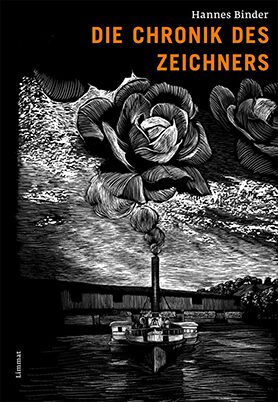Hannes Binder
Die Chronik des Zeichners
[The illustrator’s chronicle]
- Limmat Verlag
- 2014
- ISBN 978-3-85791-737-0
- 160 Pages
- 13 Suitable for age 14 and above
- Publisher’s contact details
Hannes Binder
Die Chronik des Zeichners
[The illustrator’s chronicle]
This book was showcased during the special focus on Arabic II (2015 - 2018).
Sample translations
“A Good Eye Is Tender Feeling”
The young and unexperienced observer is drawn in as if by magic in the imagery of Swiss artist Hannes Binder, whose latest work “The Illustrator’s Chronicle,” tells the story of his great grandfather, linking it to his own life as an illustrator and painter.
How can this be possible from the very first page of a graphic novel: that the reader is drawn into another era, an unknown universe, as if through a magic door? First and foremost this has to do with the unique world of shadow and light of artist Hannes Binder. Binder’s illustrations are unmistakable. His unusual technique, reminiscent of woodcuts, makes them immediately recognizable. One of the most celebrated illustrators and graphic novel artists in Switzerland, Binder has revived an old technique, which the Italians call incisione finta, the “feigned incision.” A piece of cardboard is coated with an extremely thin layer of plaster, which in turn is covered with an equally thin film of black pigment. This black coating is then worked in detail with knifes and needles. A plate is thus created with white lines on a black background. He scrapes and scratches light out of darkness, bringing out nuances that are hidden behind the façade of a world which, superficially, might appear to be black-and-white.
Hannes Binder's story about the life of his great grandfather delves deep into the day-to-day affairs of an industrious Swiss town and a local craftsman’s family whose life is directly affected by the industrial progress of the nineteenth century. But the story points beyond these narrow circumstances. While Binder narrates the conservative life of a comb-maker and the transcendent fantasies of a young man whose dreams are bigger than his opportunities, the viewer gets a taste of the events transpiring outside the frame of vision. Binder’s journey of discovery is repeatedly interrupted and broadened by references to his own life story as a painter and illustrator, taking us, for example, to the art scenes of Milano and Hamburg in the 1960s and 1970s, and even to Morocco in the late 1990s.
Diary entries and documents left behind by Binder’s grandmother shed light on this forgotten era in small towns like this on the upper reaches of the Rhine.
In a taproom we accompany a catskin dealer, Mugg, as a merry and musty group of men welcome the newcomer in their midst. Honorable citizens of the town – including an Indian expert for textile dyes – talk big about everything under the sun and the unstoppable advance of industrialization. Their musings meander from existentialist thought bubbles to hymns of praise for the local marksmen’s festival – nightmarishly visionary scenes. The moods and sentiments expressed within these narrow confines can sometimes seem suffocating, even though the catastrophes of the twentieth century still loom beyond the horizon.
It is in this milieu that Binder’s grandfather Theo grows up, a young man who loves art and an innkeeper’s daughter to boot, and who dreams of becoming a painter. In these troublesome times he even comes under suspicion of murdering the catskin dealer out of jealousy. Theo, the son of a comb-maker, will yield to the exhortations of his parents and friends not to pursue an unprofitable career in this time of great social and technical transformation. He later becomes a merchant. After all, industry is threatening traditional trades and photography is making painting redundant.
“It’s good practice in seeing and feeling things; in other words, a good eye is nothing but fine and tender feeling,” Binder comments in his surprisingly complex graphic novel about the artistic ambitions of his great grandfather – which nearly a century later were fulfilled by his great grandson, in a way no one would have unexpected.

How can this be possible from the very first page of a graphic novel: that the reader is drawn into another era, an unknown universe, as if through a magic door? First and foremost this has to do with the unique world of shadow and light of artist Hannes Binder. Binder’s illustrations are unmistakable. His unusual technique, reminiscent of woodcuts, makes them immediately recognizable. One of the most celebrated illustrators and graphic novel artists in Switzerland, Binder has revived an old technique, which the Italians call incisione finta, the “feigned incision.” A piece of cardboard is coated with an extremely thin layer of plaster, which in turn is covered with an equally thin film of black pigment. This black coating is then worked in detail with knifes and needles. A plate is thus created with white lines on a black background. He scrapes and scratches light out of darkness, bringing out nuances that are hidden behind the façade of a world which, superficially, might appear to be black-and-white.
Hannes Binder's story about the life of his great grandfather delves deep into the day-to-day affairs of an industrious Swiss town and a local craftsman’s family whose life is directly affected by the industrial progress of the nineteenth century. But the story points beyond these narrow circumstances. While Binder narrates the conservative life of a comb-maker and the transcendent fantasies of a young man whose dreams are bigger than his opportunities, the viewer gets a taste of the events transpiring outside the frame of vision. Binder’s journey of discovery is repeatedly interrupted and broadened by references to his own life story as a painter and illustrator, taking us, for example, to the art scenes of Milano and Hamburg in the 1960s and 1970s, and even to Morocco in the late 1990s.
Diary entries and documents left behind by Binder’s grandmother shed light on this forgotten era in small towns like this on the upper reaches of the Rhine.
In a taproom we accompany a catskin dealer, Mugg, as a merry and musty group of men welcome the newcomer in their midst. Honorable citizens of the town – including an Indian expert for textile dyes – talk big about everything under the sun and the unstoppable advance of industrialization. Their musings meander from existentialist thought bubbles to hymns of praise for the local marksmen’s festival – nightmarishly visionary scenes. The moods and sentiments expressed within these narrow confines can sometimes seem suffocating, even though the catastrophes of the twentieth century still loom beyond the horizon.
It is in this milieu that Binder’s grandfather Theo grows up, a young man who loves art and an innkeeper’s daughter to boot, and who dreams of becoming a painter. In these troublesome times he even comes under suspicion of murdering the catskin dealer out of jealousy. Theo, the son of a comb-maker, will yield to the exhortations of his parents and friends not to pursue an unprofitable career in this time of great social and technical transformation. He later becomes a merchant. After all, industry is threatening traditional trades and photography is making painting redundant.
“It’s good practice in seeing and feeling things; in other words, a good eye is nothing but fine and tender feeling,” Binder comments in his surprisingly complex graphic novel about the artistic ambitions of his great grandfather – which nearly a century later were fulfilled by his great grandson, in a way no one would have unexpected.
Translated by David Burnett

By Siggi Seuß
Siggi Seuß, freelance journalist, radio script writer and translator, has been writing reviews of books for children and young people for many years.
